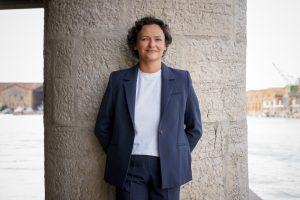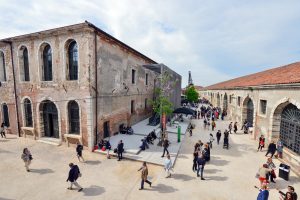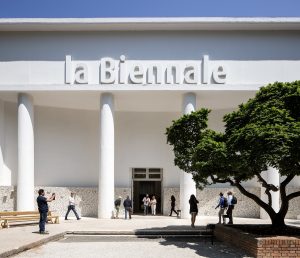There is a woman conducting the 59th Venice Biennale which will inaugurate in 2022: Cecilia Alemani is a curator with international experience, started many years ago in New York, the city where she lives. We must immediately say that she is the first Italian woman to hold this position. The first, finally. Already from the choice of the title for this Biennale, The milk of dreams, a sense of dreamlike imagination emerges and a strong sense of motherhood where the symbol of milk universally expresses a generative force. A title that could not come to mind to any male curator, with the exception perhaps of a divine creature, like Zeus, who gave birth to Athena from his head, helped by Hephaestus or Prometheus, who opened his skull with an ax blow . The objective, here, is certainly not to create a disconcerting vision or to mock men or Zeus, but rather to point out that the first Italian female curator of the Biennale of visual arts should be recognized as having chosen a “fertilizer”, fluid and evocative term. In fact, this word carries with it many suggestions: it is associated with the idea of breastfeeding and nutrition or with that of pastoral culture, in reference to which the image of milk in the fifth century was associated by the philosopher Chevalier Gheerbrant, author of the Dictionnaire des symboles (1977), to the words of God, identifying precisely in this nourishment the power to “make the living grow”.
But with Cecilia Alemani this milky drink will make the public’s imagination grow with visionary dreams to deliver the mystery of life in a dreamlike and suggestive way in a union with new technologies towards a redefinition of the idea of art and existence in its constant transformation. It is no coincidence, in fact, if the other term that is part of the title is the word “dreams” which refers to the explicit evocation of the collection of mysterious fables by the surrealist painter and writer Leonora Carrigton, also titled The milk of dreams. So, another woman to refer to: an artist intimately linked to one of the greatest surrealist artists such as Max Ernst, with whom she was a life partner for a long time. A way to redeem also the figure of Carrigton with her artistic and visionary flights of fancy – whose enigmatic tales seem to create disquiet for children and adults – to seal this 59th Biennale in the name of dreamy utopias and restore skin and face to the infinite possibility of the imaginative with “new alliances between different species” with “permeable, hybrid and multiple beings, such as the fantastic creatures invented by Carrington,” said Alemani.
The exhibition will be divided into three thematic areas: the relationship with technologies; the metamorphosis of bodies and their representation; the relationship between the body and the earth. In this regard, as the curator claims, this exhibition is also born from a series of discussions and dialogues with artists not only on the pandemic, but also on the criticality of the environmental issue and on the intensification of social tensions. From this it emerges that on the one hand “many artists portray the end of anthropocentrism, celebrating a new communion with the non-human, with the animal and with the earth, enhancing a sense of affinity between species and between the organic and the inorganic, between the animate and the inanimate”, on the other hand “others react to the dissolution of presumed universal systems, rediscovering local forms of knowledge and new identity policies. Still others practice what the feminist philosopher and activist Silvia Federici describes as the “re-spell of the world”, mixing indigenous knowledge and individual mythologies, in ways not unlike those imagined by Leonora Carrington”. In short, another woman cited by Alemani who already from these statements clarifies and defines some premises for the next Biennale, whose visionary vocation is represented, up to now, by a symbolic triptych of feminine thoughts: Alemani, Carrington and Federici. In addition, the usual exhibition venues for National Participations have been confirmed at the Giardini, at the Arsenale and then in the historic center of the lagoon city. While collateral events will be provided by international institutions. All that remains is to wait for this edition for an imaginative and utopian cosmogony in the opaque darkness of our present. To understand, in the words of the curator, “who and what we can become”.
 Cecilia Alemani, Photo by Andrea Avezzù, Courtesy La Biennale di Venezia
Cecilia Alemani, Photo by Andrea Avezzù, Courtesy La Biennale di Venezia
 Arsenale, Photo by Andrea Avezzù, Courtesy La Biennale di Venezia
Arsenale, Photo by Andrea Avezzù, Courtesy La Biennale di Venezia
 Padiglione Centrale Giardini, Photo by Francesco Galli, Courtesy of La Biennale di Venezia
Padiglione Centrale Giardini, Photo by Francesco Galli, Courtesy of La Biennale di Venezia

Through art she feels the need to get closer to nature, deciding to create an artistic residence on Etna as a “refuge for contemporary art” for artists and scholars. Thus was born Nake artistic residence. She won the Responsible Etna Award 2015. In 2017, she was invited to the Sala Zuccari, Senate of the Republic, as an art critic. She writes for Italian and foreign artists. Curator of the first Museum of Contemporary Art of Etna and of the “Contemporary Etna” project.






NO COMMENT